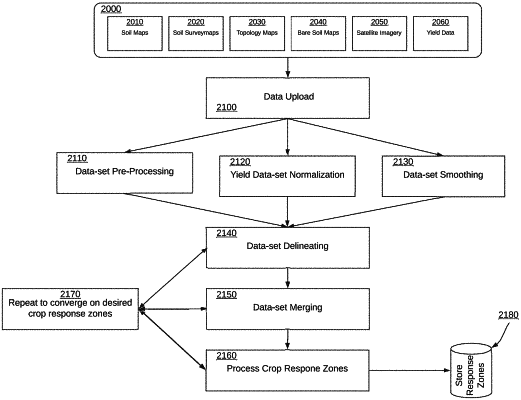| CPC G06N 5/04 (2013.01) [G01N 27/04 (2013.01); G01N 33/24 (2013.01); G06F 16/29 (2019.01); G06N 20/20 (2019.01); G01N 2033/245 (2013.01); G06N 5/01 (2023.01)] | 20 Claims |

|
1. A method for interpolating soil chemistry variables to a plurality of plots of land, the method comprising:
providing a geospatial database associated with a crop prediction engine, wherein the geospatial database receives a plurality of soil composition information for each of the plurality of plots of land;
accessing the plurality of soil composition information for each of the plurality of plots of land, in which the soil composition information includes at least one of a plurality of measured soil sample results, a plurality of environmental results, and a plurality of soil conductivity results;
applying, by the crop prediction engine, a first interpolation training model and a second interpolation training model, wherein the first interpolation training model includes a machine learning training model and a distance field training model, wherein the second interpolation training model includes a distance weighting training model;
receiving, by the machine learning training model, the plurality of soil composition information;
generating, by the distance field training model, a plurality of spatial predictors;
applying the plurality of spatial predictors to the machine learning training model;
prioritizing, by the first interpolation training model, spatial smoothing over accuracy, in which spatial smoothing removes inaccurate interpolated results and accuracy relates to the degree the interpolated results conform to a correct value;
weighing more greatly, by the distance weighting training model, interpolated soil composition information closer to a point of interpolation than interpolated soil composition information that is further away to the point of interpolation;
prioritizing, by the second interpolation training model, accuracy over spatial smoothing;
estimating, at the crop prediction engine, a plurality of soil chemistry values at a plurality of different locations with the first interpolation training model and the second interpolation training model;
performing, by the crop prediction engine, first pass calculations using measured samples;
determining, by the crop prediction engine, from the first pass calculations one or more soil variables of a plurality of soil variables included in the soil composition information that are important soil chemistry contributors to at least one of a crop-yield response surface and a seed-type response surface; and
reducing, by the crop prediction engine, the soil composition information received by the first interpolation training model and the second interpolation training model to the one or more soil variables that are important soil chemistry contributors to at least one of the crop-yield response surface and the seed-type response surface.
|